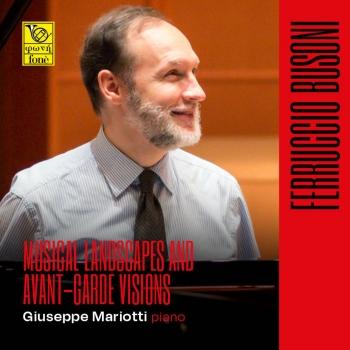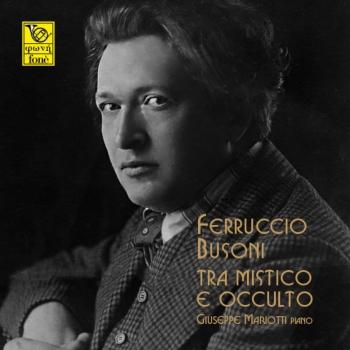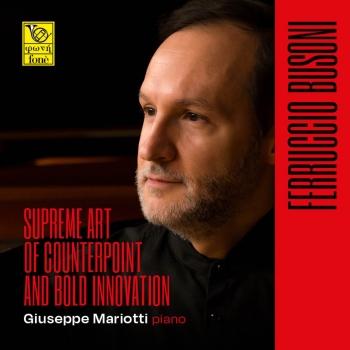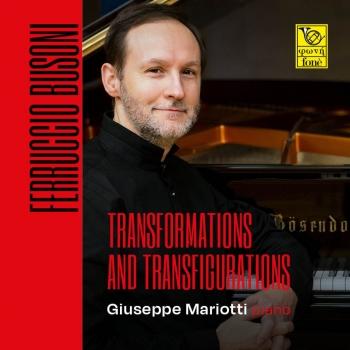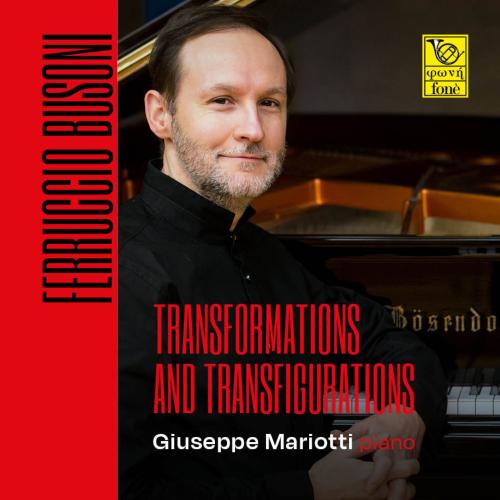
Ferruccio Busoni: Transformations and Transfigurations Giuseppe Mariotti
Album Info
Album Veröffentlichung:
1995
HRA-Veröffentlichung:
17.07.2024
Label: fonè Records
Genre: Classical
Subgenre: Instrumental
Interpret: Giuseppe Mariotti
Komponist: Ferruccio Busoni (1866-1924)
Das Album enthält Albumcover Booklet (PDF)
- Ferruccio Busoni (1866 - 1924): Sonatina Brevis. In signo Johannis Sebastiani Magni:
- 1 Busoni: Sonatina Brevis. In signo Johannis Sebastiani Magni 05:09
- Elegien:
- 2 Busoni: Elegien: Nr. 2 All’Italia. In modo napolitano (Andante barcarolo) 05:46
- 3 Busoni: Elegien: Nr. 1 Nach der Wendung. Recueillement (Sostenuto, quasi Adagio) 04:24
- 4 Busoni: Elegien: Nr. 4 Turandots Frauengemach. Intermezzo (Andantino sereno - Più vivo e distaccato e ritmato) 04:47
- 5 Busoni: Elegien: Nr. 7 Berceuse (Andantino calmo) 05:54
- Sonatina super “Carmen”:
- 6 Busoni: Sonatina super “Carmen” 07:59
- Choral Vorspiel über ein Bachsches Fragment:
- 7 Busoni: Choral Vorspiel über ein Bachsches Fragment 04:30
- Nuit de Noel. Esquisse pur le piano:
- 8 Busoni: Nuit de Noel. Esquisse pur le piano 04:36
- Toccata. Preludio - Fantasia - Ciaccona, Quasi Presto, arditamente - Sostenuto, quasi Adagio - Allegro risoluto:
- 9 Busoni: Toccata. Preludio - Fantasia - Ciaccona, Quasi Presto, arditamente - Sostenuto, quasi Adagio - Allegro risoluto 10:49
Info zu Ferruccio Busoni: Transformations and Transfigurations
Ferruccio Busoni stands as a towering figure in the musical landscape of the turn of the century. His unbridled activity as a man and musician shaped his entire life, and his universal genius allowed him to reach absolute and, unfortunately often misunderstood, artistic heights. His impressive virtuosity never seemed imposing, and his avant-garde and highly original musical vision became legendary. Beloved by audiences since his youth, he often baffled critics. His later compositions in particular rank among the most important and brilliant of his time: his works for piano and especially those for orchestra and opera influenced an entire generation of musicians. He vehemently advocated for the performance and publication of works and critical essays of then-contemporary music. Arnold Schoenberg, for example, who succeeded him as teacher of the composition class at the Berlin Academy of Music, found great support in his work through Busoni. Busoni's literary education and keen intellect allowed him to write the text of his operas himself, to correspond with the greatest figures of his time, and to publish some essential works, of which the most significant is the Entwurf einer neuen Ästhetik der Tonkunst (Sketch of a New Aesthetic of Music) (1907), in which he describes pioneering intuitions, such as the dodecaphonic system, microtonality, and new notation systems, and even makes predictions about electronic music. He was the inspirer of a new piano construction, namely the Imperial model of the Viennese piano manufacturer Bösendorfer, which was also used for this recording.
Giuseppe Mariotti, piano
Giuseppe Mariotti
Unkonventionelle Pfade, und eine Vorliebe für musikalisch anspruchsvolle Komponisten haben den Lebensweg von Giuseppe Mariotti charakterisiert. So hat zum Beispiel seine Aufnahme des Gesamtwerkes für Klavier von Ferruccio Busoni große Anerkennung und den Beifall der internationalen Musikkritik gefunden. Auch fand seine Konzertreihe in Wallfahrtstempeln der Japanischen Insel Shikoku regen Zuspruch.
Seine Konzerttätigkeit als Solist und Kammermusiker brachte ihn in die meisten europäischen Länder, in die USA, sowie nach Rußland und Israel, Japan, Südkorea, Singapur und viele weitere Länder, wo er zahlreiche Rundfunk- und Fernsehaufnahmen z.B. für ORF, RAI oder NHK machte.
Giuseppe Mariotti ist ein Bösendorfer Artist, zu dessen großen Repertoire Werke von Bach bis zu zeitgenössischen Komponisten zählen. Er bevorzugt die Kompositionen der Wiener Klassik, die er auch gern auf Originalinstrumenten seiner Sammlung spielt, und die italienische Klavierliteratur, insbesondere das 20. Jahrhundert. Die besonders prägnante Kraft seiner Aufführungen, die eine kongeniale Verschmelzung von Tradition und Exegese darstellt, wird immer wieder von Publikum und Kritikern hervorgehoben und gelobt.
In seiner Funktion als Generalmusikdirektor der Minoritenkirche in Wien war er 1995 bis 2003 indirekter Nachfolger von Antonio Salieri, nach dem er auch das von ihm gegründete „Ensemble Salieri Wien“ benannt hat.
Nach seinem Klavier-, Orgel- und Kompositionsstudium am Konservatorium von Piacenza (Italien) übersiedelte er 1982 nach Wien, wo er an der Hochschule für Musik und darstellende Kunst (jetzt Universität für Musik) sein Klavier-Konzertfachstudium bei Prof. Hans Graf und Klavierkammermusik bei Prof. Georg Ebert abschloss.
Auf Einladung der Universität für Musik und Darstellende Kunst Wien kam er 2003 als Gastprofessor für Klavier Konzertfach an die Tokushima Bunri University (Japan). Seit 2007 ist er o. Univ.-Professor und als Dekan der dortigen Musikfakultät tätig.
2008-2010 war er auch Gastprofessor am Kobe College of Music (Japan), und seit 2009 unterrichtet er als Dozent des Wiener Musikseminars an der Musikuniversität Wien.
Mit dem Italienischen Geiger Mauro Iurato hält er seit 1998 als “UniDuo” rege Konzerttätigkeit in Japan und Europa.
Er hält regelmäßige Meisterkurse in Tokyo und Osaka, sowie in Südkorea und Taiwan. Giuseppe Mariotti ist Jurymitglied mehrerer internationaler Wettbewerbe und Vorsitzender der Tokushima Music Competition. Als Autor schreibt er für namhafte Musikzeitschriften, darunter eine populäre Rubrik über Klaviertechnik in der Yamaha Klavierzeitschrift „Piano no Hon“.
Booklet für Ferruccio Busoni: Transformations and Transfigurations









